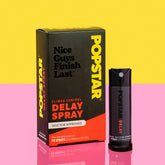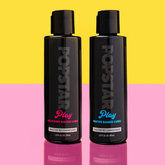

Key Takeaways
Male menopause — also known as andropause or late-onset hypogonadism — is caused by declining testosterone levels
Symptoms include low libido, fatigue, erectile dysfunction, brain fog, mood swings, and reduced muscle mass
A simple blood test can confirm if you’re experiencing low testosterone
Testosterone therapy can help but comes with side effects and requires medical supervision
Lifestyle changes like exercise, sleep, diet, and stress management can naturally support healthy T levels
The Not-So-Secret Decline: What Is Male Menopause Anyway?
You’ve probably heard women talk about “the change” — hot flashes, mood swings, spontaneous crying during coffee commercials. But men? We tend to keep quiet, even when something’s... off. You might not be dealing with periods, but that doesn’t mean your hormones aren’t on their own midlife rollercoaster.
Enter male menopause. Also known as andropause, late-onset hypogonadism, or if you’re feeling particularly dramatic, male manopause. It’s real. It’s hormonal. And it can hit anywhere from your 40s to your 70s — no permission slip required. No, you don’t lose your period. But you might lose your pep, your pump, and your pants-on enthusiasm.
Unlike female menopause, which has a definitive start line (goodbye periods) and tends to hit like a hormonal cliff dive, male menopause is more of a slow leak. The culprit? Declining testosterone levels — and the grab bag of symptoms that sneak in when your T dips too low for comfort. The good news? You’ve got options. The better news? We’re going to talk about them like grown-ups who can laugh about a limp libido without ignoring the science behind it.
It’s All About the T
Testosterone is the hormone MVP behind everything from your muscle mass to your mood. It’s what gave you your first facial hair, your first nocturnal emission, and possibly your first wildly misguided cologne purchase.
This hormone powers sperm production, bone density, red blood cell production, sex drive, energy, and yes — your ability to rise and shine (in more ways than one). Women make it too, but men typically make 10 to 20 times more. So when testosterone starts to dip, it can feel like the wheels are coming off the cart.
Here’s the thing: testosterone naturally declines with age. Starting around 40, your levels start to trickle down by about 1% per year. That might not sound like much, but after a decade or two, your body might start whispering — or shouting — that something’s off.
When the Tank Starts to Empty
Androgen deficiency in aging males sounds fancy, but it just means your testosterone isn’t pulling its weight anymore. Not every guy feels the drop, but when it happens, the symptoms are very real and very annoying. You might notice:
Low energy or motivation (suddenly “dad nap” is a daily ritual)
Lower libido (your desire clock might be stuck on snooze)
Erectile dysfunction or fewer spontaneous erections
Depression, mood swings, irritability
Hot flashes or night sweats (yep, you get those too)
Weight gain, especially around the middle
Brain fog and memory issues
Swollen or tender breasts
Reduced muscle mass or strength
A general feeling that someone unplugged your battery
These are all signs of low testosterone — also known as low T — and they can absolutely impact your daily life, relationships, and overall sense of confidence. Clinically low T is diagnosed as late-onset hypogonadism, a very real condition that affects an estimated 30% of adult men. And before you ask — yes, it happens to gay men, straight men, bi men, pan men, and men who just like a good bath bomb and don’t want to label things.
How to Know If It’s Low Testosterone
Feel like you’re dragging through life with half your former spark? It might be time for a little hormonal investigation. Your doctor can run a simple blood test (ideally first thing in the morning when testosterone is highest) to measure your levels.
If those numbers come back low and there’s no other obvious cause for your symptoms, you may be diagnosed with low testosterone. That opens the door to treatment — but it’s not a one-size-fits-all scenario.
Side note: don’t go diagnosing yourself based on an Instagram Reel. Hormones are complicated. Let a professional sort it out.
Testosterone Replacement Therapy: Hype, Help, or Hazard?
For many guys, testosterone replacement therapy (TRT) is a game-changer. It can restore energy, improve mood, increase sex drive, boost muscle mass, and bring back the kind of morning wood that makes you high-five yourself.
But it’s not magic. TRT comes with its own set of pros, cons, and fine print. You’ve got options. Testosterone can be delivered through:
Daily skin patches
Gels or creams
Injections (weekly or biweekly)
Buccal tablets (you press them to your gum like a nicotine lozenge with ambition)
Long-lasting pellets under the skin
Even nasal sprays (for the guy who wants hormone therapy with a twist of allergy season)
Sounds easy, right? Mostly. But here’s the deal. There are real testosterone therapy side effects. We’re talking:
Acne or oily skin
Breast enlargement
Increased red blood cell count (which can lead to clotting issues)
Potential for sleep apnea to worsen
Infertility — because when you flood the body with testosterone, your testicles can sometimes decide to take early retirement
There’s also been concern about testosterone therapy increasing the risk of prostate cancer. To be clear, TRT doesn’t cause prostate cancer. But if you already have undiagnosed prostate issues, it could speed things up. The same goes for heart risks — some studies suggest a link between TRT and heart attack or stroke, though research is ongoing.
In other words: this isn’t something you DIY. It’s a “talk to your doctor and monitor regularly” kind of situation.
Natural Ways to Boost Testosterone (That Don’t Involve Needles or Pellets)
Not ready to jump on the TRT train? Totally fair. There are plenty of natural ways to support testosterone levels, and they come with zero copays and no post-injection soreness.
Here’s your hormone-friendly lifestyle starter pack:
Lift heavy things : Strength training boosts testosterone and keeps your bones and muscles strong.
Get your heart rate up : Cardio improves circulation and supports overall hormone health.
Fix your sleep : Aim for 7–9 hours of real, restful sleep. Your T levels need beauty rest too.
Eat like a grown-up : Balanced meals with healthy fats, protein, and fewer ultra-processed foods support hormonal balance.
Manage stress : Chronic stress increases cortisol, which can tank testosterone faster than a breakup during Mercury retrograde.
Have more sex : Yes, really. Sexual activity helps regulate testosterone production. It’s a hormone feedback loop you’ll actually enjoy.
And if you want a little help in the “quality and quantity” department, Popstar’s Volume + Taste Supplement is packed with nutrients that support sperm health and taste appeal. You bring the confidence. We’ll bring the flavor.
The Upside of Aging (Yes, There Is One)
Here’s a little secret no one tells you when you're younger: aging isn’t just about what’s slowing down. It’s about what gets better, too.
More confidence. More self-awareness. A lower tolerance for crap and a higher appreciation for naps, skincare, and sex that lasts longer than a song on Spotify.
While testosterone decline with age is a reality, you can still be thriving, satisfied, and sexually active well into your 60s, 70s, and beyond. Fertility might dip, but it doesn’t disappear. Libido may fluctuate, but it doesn’t flatline. And with a little self-awareness and support, you can absolutely feel like a Popstar in your own skin — wrinkles, wisdom, and all.
Conclusion: You’re Not Broken. You’re Just in a New Season.
Male menopause is real. The symptoms are real. And thankfully, so are the solutions. Whether you’re navigating your first hot flash or wondering why your workouts feel like punishment lately, understanding what’s happening in your body is the first step toward feeling like yourself again.
From blood tests to boosters, lifestyle tweaks to testosterone therapy, you’ve got options. And you don’t have to go it alone. Talk to your doctor, make informed choices, and know that Popstar’s got your back (and your front).
Need a boost below the belt? Explore our Delay Spray to keep the good times rolling or Volume + Taste Supplement to bring more to the table. Literally.
Frequently Asked Questions
What exactly is male menopause?
It refers to the age-related decline in testosterone production. Unlike female menopause, male menopause doesn’t happen all at once and doesn’t involve a clear-cut timeline. Think of it more like a hormonal slow fade.
Is testosterone therapy safe?
It can be — with proper monitoring. Like any medical treatment, there are risks and benefits. Talk to your doctor about your personal health history and stay on top of bloodwork.
Can I boost testosterone without medication?
Yes. Lifting weights, eating well, getting quality sleep, and managing stress can all support testosterone naturally. Having regular sex also helps.
Will testosterone therapy affect my fertility?
It might. TRT can lower your sperm count, so if you’re planning to have kids, discuss this with your provider before starting treatment.
What is bioidentical hormone replacement?
It’s a form of hormone therapy using compounds structurally identical to those made by your body. Some believe it’s more “natural,” but it carries similar risks and benefits as standard testosterone therapy.










